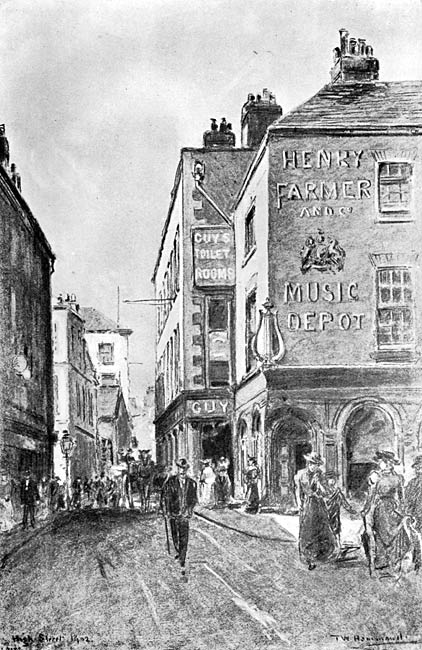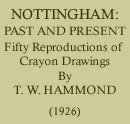< Previous | Contents | Next >
NOTTINGHAM PAST & PRESENT: STREETS AND YARDS
HIGH STREET, 1902

This drawing shows us a very different High Street to the one with which we are familiar. It was one of the chief streets of old Nottingham, and at the corner of High Street and Pelham Street stood the great inn known as the 'Blackamore's Head', which was one of the most important inns of the Midlands during coaching days, and within whose walls lay Lord Byron's body before its interment at Hucknall in 1824.
But High Street possesses other memories, for in 1799 Joseph Raynor was appointed first postmaster in Nottingham and he had his post office on the left side of this picture. He was assisted by a letter carrier of the name of Thomas Croft, who used to perambulate the town morning and evening carrying a great bell which he rang from time to time. In the mornings he took out the letters which had arrived at the Nottingham Post Office, and to obtain them it was necessary to listen for his bell and apply to him, while in the evening he collected any letters that might be ready for the post. So little postal business was there that Raynor was able to conduct a successful seedsman's business in his spare time. In 1813 the office was moved to the other side of High Street, and was situated in Armitage Place, and the increase of business warranted the raising of the staff to four persons. In 1834 the Post Office was again moved, this time to Bridlesmith Gate. In 1840, penny postage was introduced and at the same time the Nottingham Post Office was once more moved, this time to a building at the north east corner of the newly formed Albert Street. In 1846 a new building was commenced, which was completed in 1847, and stands to-day as the City Treasurer's Office, at the corner of St. Peter's Church Side and Albert Street: within its walls postal business was transacted until 1868, when the old Post Office, at the top of Victoria Street was constructed. In 1895 the present Post Office in Queen Street was occupied. How recent are modern conveniences, may be gauged from the fact that the first pillar post boxes were erected in Nottingham in 1857, while it was not until 1858 that the letter carriers were provided with uniforms.
The name High Street, which is so common in all old towns, is derived from the Old English word 'heagh', which means 'chief.
